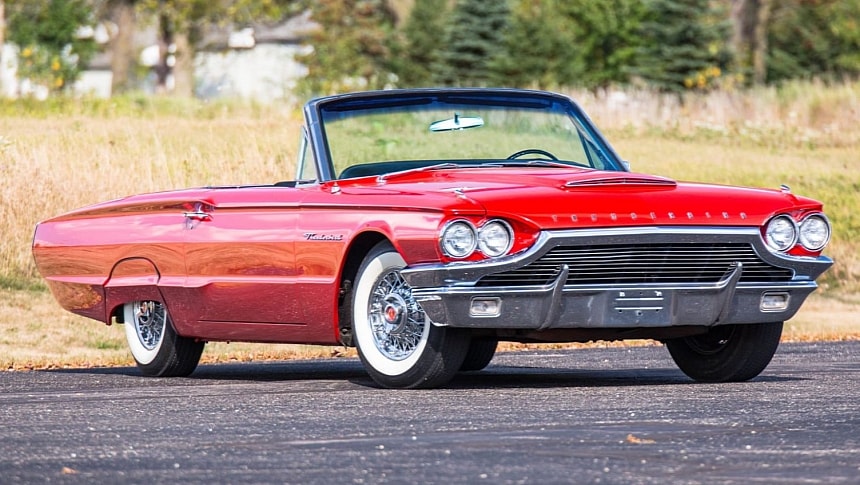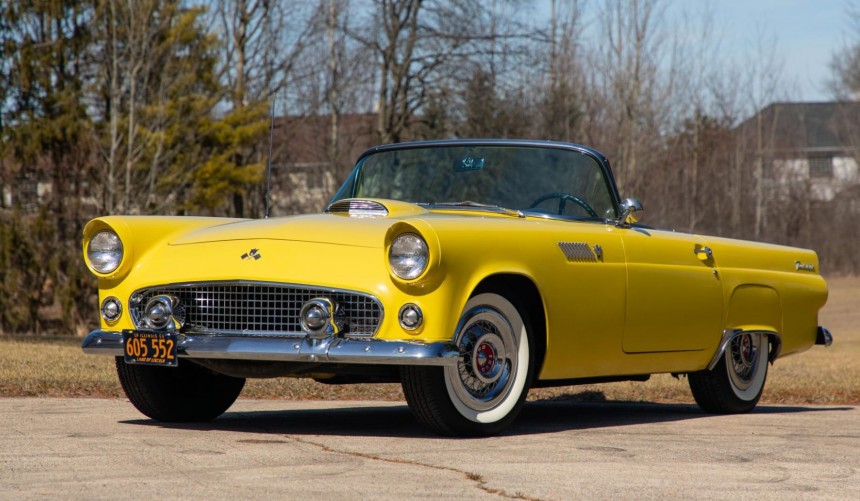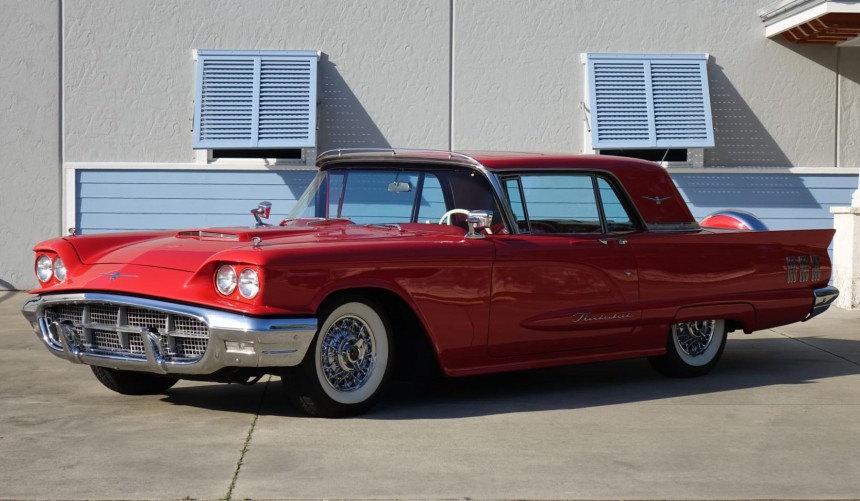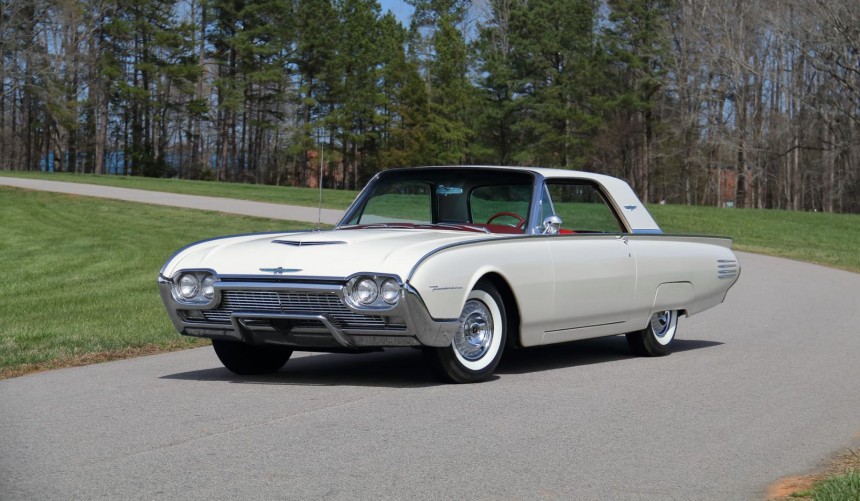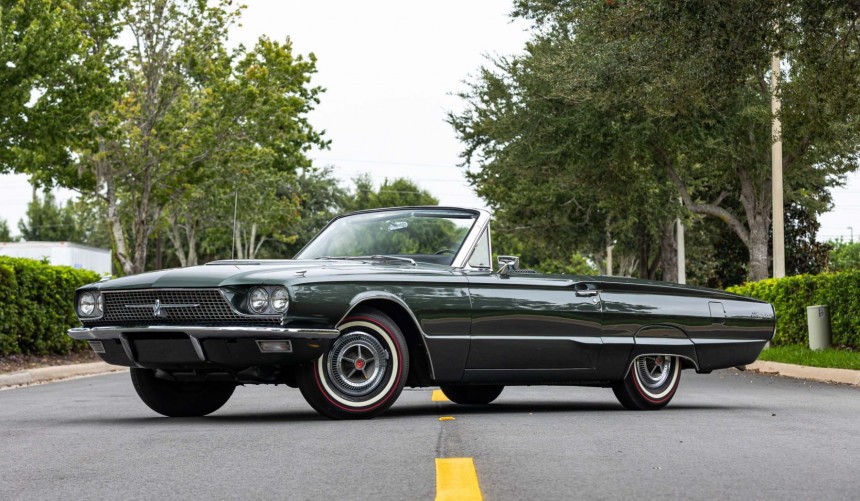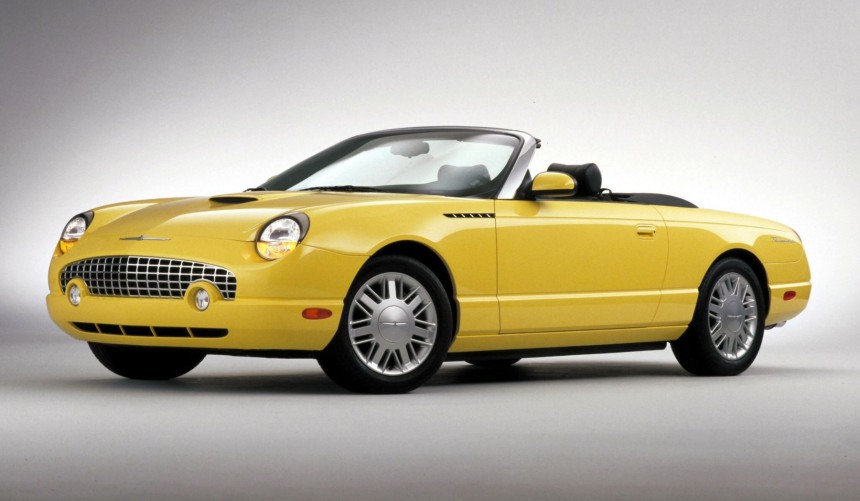Sometimes forgotten, particularly by younger enthusiasts, the Thunderbird was a game-changer for the American automotive industry.
Nearly seventy years ago, in the fall of 1954, Ford commenced production of an all-new two-seat convertible dubbed Thunderbird.
Available with potent V8 power, it was never marketed as a sports car but as a Euro GT-like luxury car, which eventually coined the personal luxury car segment in the US.
Produced in ten consecutive generations, with an eleventh, retro-inspired version coming in 2002, after a five-year hiatus, the T-Bird became one of Ford's most iconic models and one of the most legendary American cars of all time.
Nearly seven decades after the famous model was introduced, we take a look back at its five greatest iterations.
Naturally, the first entry on our list is the generation that started it all.
Unveiled at the Detroit Auto Show on February 20, 1954, the original T-Bird was Ford's answer to Chevy's Corvette, which debuted in prototype guise just a month earlier.
Though it aimed to compete against the Corvette, the Thunderbird was dubbed "a personal car of distinction" rather than a Euro-inspired two-seat sports car.
It entered production in October 1954 as a 1955 model and impressed potential buyers with its gorgeous design, luxury amenities, and, of course, build quality.
Initially, power came from Ford's 292-ci (4.8-liter) OHV Y-block, marketed as the Thunderbird Special V8. Rated at 200 or 202 hp (depending on the gearbox), the 292 provided a bit more power than a small-block V8-powered Corvette (195 hp).
A year later, a more powerful 312-ci (5.1-liter) version of the Y-block was added to the options list, and by 1957, the first-generation's last year of production, the T-Bird was available with a supercharged 312 that made up to 340 hp.
By the time it was replaced by the improved, second-generation, the original Thunderbird became extremely popular, particularly among the country's elites.
With Ford management determined to boost sales even further, the Thunderbird received its first major redesign for the 1958 model year.
Apart from the obvious styling improvements that introduced a more squared-off design, the T-Bird was now available as a full-fledged hardtop (an optional fiberglass hardtop was previously available) in addition to the classic convertible.
However, unquestionably, the most important upgrade was the addition of a rear seat, which made the model far more suitable for families.
MotorTrend magazine's Car of the Year in 1958, the second-generation was now powered by Ford's new 352-ci (5.8-liter) FE rated at 300 hp.
A year later, an optional 430-ci (7.0-liter) version of the MEL (Mercury, Edsel, Lincoln) gave the personal luxury car a performance bump to 375 hp.
The second generation was produced until the end of the 1960 model year, with total sales exploding from 53,166 (1st gen) to 198,191 units.
As successful as the second-generation was, by 1960, the US automotive industry was entering a new era of design and the Thunderbird had to follow suit.
Ford's best designers worked hard on another major redesign, and for the 1961 model year, the all-new T-Bird was introduced.
Far more modern than its predecessors, the third-generation introduced several firsts for a production car.
These included features like a floating rear view mirror and, more notably, the 'Swing Away' steering wheel, which, as the name implied, allowed drivers to swing away the steering wheel when the transmission was in the "Park" position to make getting in and out of the car easier.
Moreover, it was one of the first American production cars to offer premium features like power steering, power brakes, or bucket seats as standard.
In terms of the powertrain, the redesigned personal luxury came with a new 390-ci (6.4-liter) FE rated at 300 hp. In 1962, a special high-performance version of the 390 dubbed M-Code was introduced, and although it was rated at a healthy 340 hp, the V8 actually made more power than advertised.
Like its predecessor, the third generation was produced during a three-year span, at the end of which the total sales jumped to 214,375 units.
In 1964, the Thunderbird received another major redesign, receiving more aggressive lines that seemed inspired by the wildly popular Mustang, becoming more formal than its predecessor.
By 1965, it received state-of-the-art features like sequential turn signals, power disc brakes, and minor exterior tweaks.
Under the hood, the fourth-generation hid a standard 390, carried over from its predecessor. Initially, it made 300 hp, but in 1966, its output increased to 315 hp.
Starting with the 1965 model year, Thunderbird buyers could equip their ride with a new optional V8, the 428-ci (7.0-liter) FE that made 345 hp.
The T-Bird remained the best-selling personal luxury car in the US, with total sales of the fourth generation climbing to 236,613 units.
With market trends changing, the fifth generation, which went into production in 1966, was more focused on the luxury aspect and, for the first time, it was available as a four-door sedan, in addition to the traditional two-door convertible and hardtop models.
From the fourth-gen onwards, the T-Bird's styling became more and more subdued, particularly when compared to the first four iterations, but, despite sales struggles during some model years, Ford kept the nameplate alive until 1997.
When it was finally discontinued, few believed that the Thunderbird would make a comeback, and even fewer thought that the timeless design of the first four generations would ever be replicated.
Surprisingly, the T-Brid did come back in the summer of 2001 as a 2002 model. But even more surprizing was the retro-inspired styling that mixed cues from the first four generations with modern design and tech.
Though few can argue that the 2002 T-Bird was more beautiful that the first four generations, it was unquestionably a huge step up from its imediate predecesors.
Designed by Jack Telnack and J Mays, the eleventh-gen Thunderbird reverted to its original two-seat convertible configuration with a removable hardtop available as an option.
It was based on the DEW platform shared with the Lincoln LS or Jaguar S-Type, and under its hood, it hid a surprising engine.
The unit in question was a 3.9-liter Jaguar AJ30/AJ35 rated at 252 hp. Though it was built at Ford's Lima, Ohio, engine plant the engine was often criticized for not being a 100% American-designed engine befitting an icon like the Thunderbird.
Nevertheless, the DOHC V8 provided enough power for the revived T-Bird and received generally positive reviews for its reliability.
Though it was an awesome modern reinterpretation, the last Thunderbird was way too expensive at the time of its release, so, excluding the first year, its sales were modest.
Nevertheless, it's still a gorgeous modern classic and a bargain buy on the used car market.
Available with potent V8 power, it was never marketed as a sports car but as a Euro GT-like luxury car, which eventually coined the personal luxury car segment in the US.
Produced in ten consecutive generations, with an eleventh, retro-inspired version coming in 2002, after a five-year hiatus, the T-Bird became one of Ford's most iconic models and one of the most legendary American cars of all time.
Nearly seven decades after the famous model was introduced, we take a look back at its five greatest iterations.
1955–1957 Ford Thunderbird
Unveiled at the Detroit Auto Show on February 20, 1954, the original T-Bird was Ford's answer to Chevy's Corvette, which debuted in prototype guise just a month earlier.
Though it aimed to compete against the Corvette, the Thunderbird was dubbed "a personal car of distinction" rather than a Euro-inspired two-seat sports car.
It entered production in October 1954 as a 1955 model and impressed potential buyers with its gorgeous design, luxury amenities, and, of course, build quality.
Initially, power came from Ford's 292-ci (4.8-liter) OHV Y-block, marketed as the Thunderbird Special V8. Rated at 200 or 202 hp (depending on the gearbox), the 292 provided a bit more power than a small-block V8-powered Corvette (195 hp).
A year later, a more powerful 312-ci (5.1-liter) version of the Y-block was added to the options list, and by 1957, the first-generation's last year of production, the T-Bird was available with a supercharged 312 that made up to 340 hp.
By the time it was replaced by the improved, second-generation, the original Thunderbird became extremely popular, particularly among the country's elites.
1958–1960 Ford Thunderbird
Apart from the obvious styling improvements that introduced a more squared-off design, the T-Bird was now available as a full-fledged hardtop (an optional fiberglass hardtop was previously available) in addition to the classic convertible.
However, unquestionably, the most important upgrade was the addition of a rear seat, which made the model far more suitable for families.
MotorTrend magazine's Car of the Year in 1958, the second-generation was now powered by Ford's new 352-ci (5.8-liter) FE rated at 300 hp.
A year later, an optional 430-ci (7.0-liter) version of the MEL (Mercury, Edsel, Lincoln) gave the personal luxury car a performance bump to 375 hp.
The second generation was produced until the end of the 1960 model year, with total sales exploding from 53,166 (1st gen) to 198,191 units.
1961–1963 Ford Thunderbird
Ford's best designers worked hard on another major redesign, and for the 1961 model year, the all-new T-Bird was introduced.
Far more modern than its predecessors, the third-generation introduced several firsts for a production car.
These included features like a floating rear view mirror and, more notably, the 'Swing Away' steering wheel, which, as the name implied, allowed drivers to swing away the steering wheel when the transmission was in the "Park" position to make getting in and out of the car easier.
Moreover, it was one of the first American production cars to offer premium features like power steering, power brakes, or bucket seats as standard.
In terms of the powertrain, the redesigned personal luxury came with a new 390-ci (6.4-liter) FE rated at 300 hp. In 1962, a special high-performance version of the 390 dubbed M-Code was introduced, and although it was rated at a healthy 340 hp, the V8 actually made more power than advertised.
Like its predecessor, the third generation was produced during a three-year span, at the end of which the total sales jumped to 214,375 units.
1964–1966 Ford Thunderbird
By 1965, it received state-of-the-art features like sequential turn signals, power disc brakes, and minor exterior tweaks.
Under the hood, the fourth-generation hid a standard 390, carried over from its predecessor. Initially, it made 300 hp, but in 1966, its output increased to 315 hp.
Starting with the 1965 model year, Thunderbird buyers could equip their ride with a new optional V8, the 428-ci (7.0-liter) FE that made 345 hp.
The T-Bird remained the best-selling personal luxury car in the US, with total sales of the fourth generation climbing to 236,613 units.
2002–2005 Ford Thunderbird
From the fourth-gen onwards, the T-Bird's styling became more and more subdued, particularly when compared to the first four iterations, but, despite sales struggles during some model years, Ford kept the nameplate alive until 1997.
When it was finally discontinued, few believed that the Thunderbird would make a comeback, and even fewer thought that the timeless design of the first four generations would ever be replicated.
Surprisingly, the T-Brid did come back in the summer of 2001 as a 2002 model. But even more surprizing was the retro-inspired styling that mixed cues from the first four generations with modern design and tech.
Though few can argue that the 2002 T-Bird was more beautiful that the first four generations, it was unquestionably a huge step up from its imediate predecesors.
Designed by Jack Telnack and J Mays, the eleventh-gen Thunderbird reverted to its original two-seat convertible configuration with a removable hardtop available as an option.
It was based on the DEW platform shared with the Lincoln LS or Jaguar S-Type, and under its hood, it hid a surprising engine.
The unit in question was a 3.9-liter Jaguar AJ30/AJ35 rated at 252 hp. Though it was built at Ford's Lima, Ohio, engine plant the engine was often criticized for not being a 100% American-designed engine befitting an icon like the Thunderbird.
Nevertheless, the DOHC V8 provided enough power for the revived T-Bird and received generally positive reviews for its reliability.
Though it was an awesome modern reinterpretation, the last Thunderbird was way too expensive at the time of its release, so, excluding the first year, its sales were modest.
Nevertheless, it's still a gorgeous modern classic and a bargain buy on the used car market.
